Archetype Brand Strategy: Unlock Your Brand’s Potential
What makes archetype brands compelling and how do they shape brand strategy? Drawing on Carl Jung’s psychological archetypes, brands like the Hero, Sage, and Caregiver, become powerful story weavers, influencing their audience. Get ready to understand each archetype’s role and craft strategies that elevate brand connection and identity, particularly focusing on the archetype brand.
Key Takeaways
- Brand archetypes are essential subconscious influencers derived from Carl Jung’s personality types, providing brands with the tools to foster emotional connections that resonate across cultures when aligning with a company’s essence and messaging.
- Each of the 12 brand archetypes, such as the Hero, Creator, and Lover, embodies a distinct set of characteristics and values that, when consistently and authentically applied, can effectively guide a brand’s identity and narrative in the marketplace.
- While brands typically align with one primary archetype, a nuanced and dynamic brand personality can be achieved by strategically merging elements from multiple archetypes to connect with a broader audience and enhance the brand message.
Decoding the Power of Brand Archetypes
Brand archetypes are not mere marketing buzzwords; they are the very essence of a brand’s soul, drawn from Carl Jung’s universal personality types. These subconscious influencers guide behavior, shape desires, and instill values that resonate across cultures and languages. Imagine the tapestry of humanity’s stories, with 12 brand archetypes like: the Creator, the Hero, the Lover, and the Sage.
Each archetype plays a distinct role in the narrative of human desires and motivations. They are the alchemists turning ordinary interactions into emotional connections, ensuring that every sight, sound, and touch aligns with the brand’s core message.
Weaving the archetype into a brand requires a deep understanding of the company’s essence, its offerings, and the emotional responses it aims to elicit.
Understanding Your Brand’s Core Identity
A brand’s core identity is a compass guiding its journey through the competitive landscapes of commerce. By aligning a brand’s purpose, values, and personality with an archetype, a powerful brand identity emerges, resonating with consumers and guiding the narrative of the brand.
The risk of misalignment—when the brand’s identity does not match customer perception—can lead to a marketing odyssey fraught with challenges. Successful navigation of this landscape requires consistent and authentic application of the chosen archetype across all channels.
The Hero Brand Archetype: Inspiring Action and Resilience
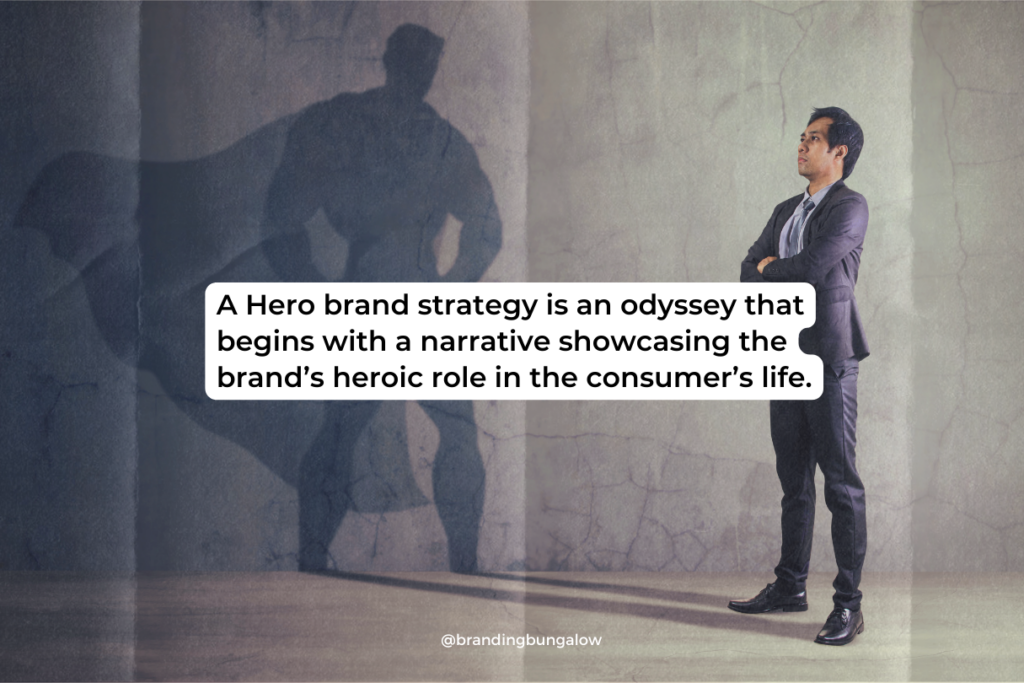
Enter the Hero archetype, a beacon of courage and determination, exemplified by brands that inspire action and resilience, like Patagonia and Nike. These Hero brands champion customer aspirations and engage deeply with their causes, creating a narrative where every customer is the protagonist in their own heroic journey. By striking an emotional chord with stories of triumph and authenticity, as seen in Nike’s celebrated athlete campaigns, these brands balance heroism with relatability.
Customers are empowered to transform into heroes in training, conquering obstacles and achieving victory.
Crafting a Hero Brand Strategy
A Hero brand strategy is an odyssey that begins with a narrative showcasing the brand’s heroic role in the consumer’s life. At its heart lies a clear goal or challenge, reflecting the trials every hero faces, much like the Saysh advertisement’s candid and inspiring narrative. Forming alliances with like-minded partners and fostering a courageous brand voice that inspires victory is crucial.
When infused with courageous actions, this strategy becomes a powerful tool for the brand, slicing through adversity and immersing audiences in a mission to prevail. Yet, it must wield this sword with humility, ensuring it does not alienate customers with arrogance or self-centeredness.
The Creator Brand: Unleashing Innovation
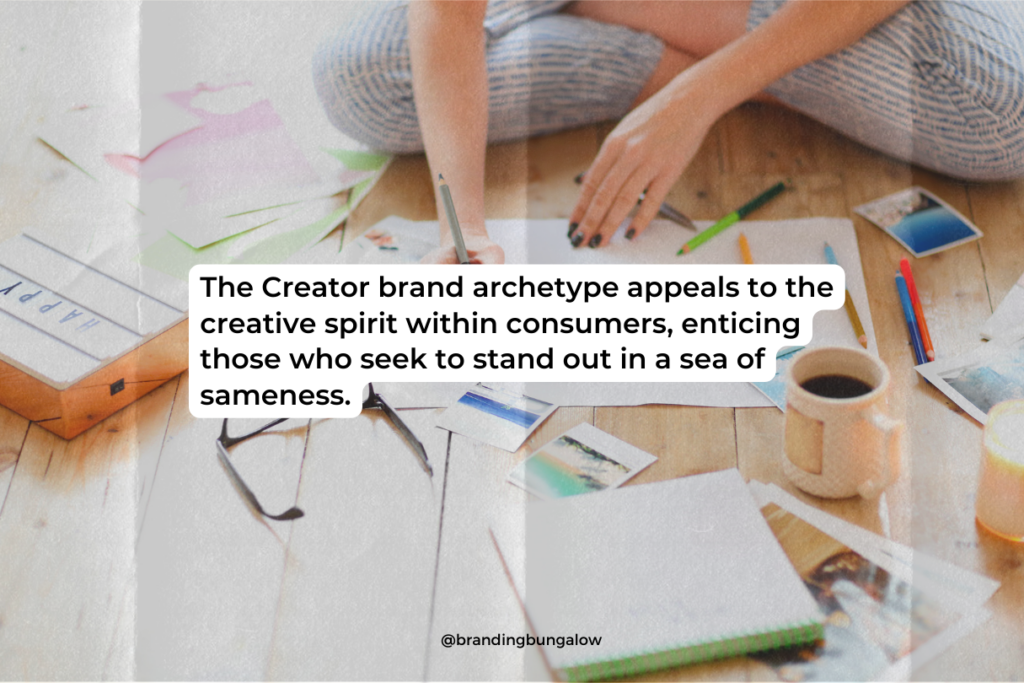
The Creator brand archetype is the visionary, the innovator, the artist. It appeals to the creative spirit within consumers, as seen in trailblazing brands like Apple. These Creator brands dance to the tune of originality and self-expression, enticing those who seek to stand out in a sea of sameness.
Their offerings serve as canvases for innovation, design, and technology, striking a chord with an audience hungry for creativity.
Implementing a Creator Brand Strategy
A Creator brand strategy is an orchestration of vision and craftsmanship that:
- Blends research and innovation to produce offerings that sing with originality
- Engages with creative communities
- Partners with influencers
- Harnesses social media to champion creativity.
This methodology leaves a lasting impression and guarantees the brand’s position as a beacon of innovation and inspiration in its sector.
Embracing the Lover Archetype: Cultivating Desire and Intimacy
The Lover archetype is the embodiment of connection and sensuality, creating intimate bonds between brands and their audience. It’s about enhancing life’s pleasures and fostering relationships, as seen in luxury and indulgence brands like Chanel and Godiva.
Lover brands cast a spell of desire and intimacy through evocative advertising, akin to Christian Dior’s campaigns, that makes consumers feel treasured.
Lover Brand Strategy Essentials
A Lover brand strategy essentials encompass a warm, passionate brand voice, rich visual aesthetics that cater to the senses, and an emphasis on personalized customer service. It’s about balancing passion with authenticity, creating marketing narratives that connect deeply with the target audience’s desires.
This strategy fosters a sense of exclusivity and indulgence, ensuring each customer feels cherished.
The Innocent Brand Archetype: Purity and Simplicity
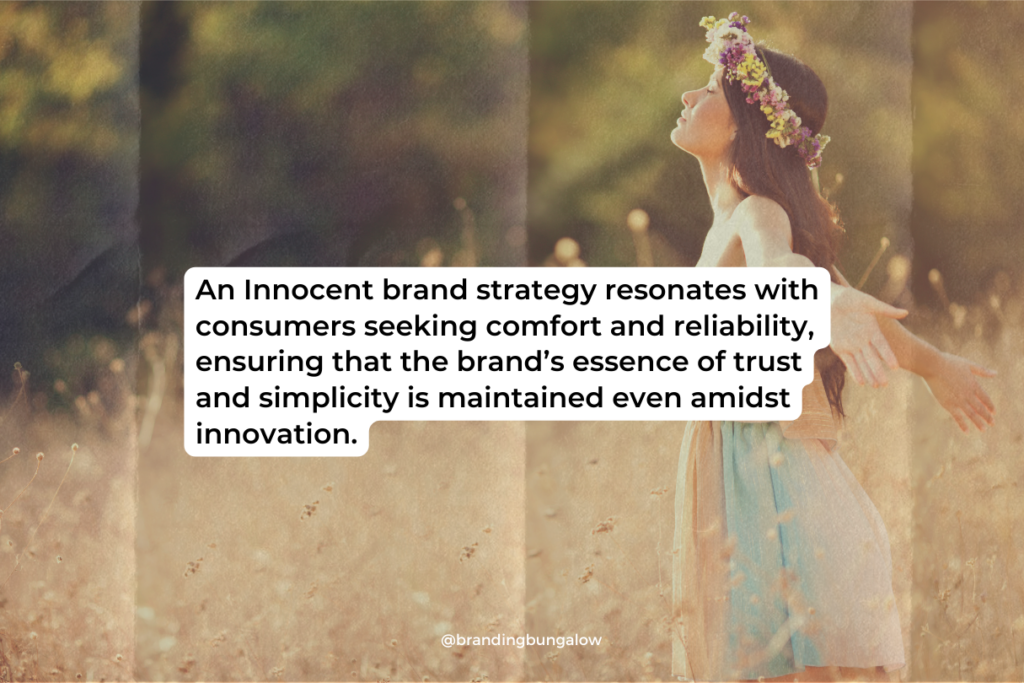
The Innocent archetype is a return to the simpler, more honest aspects of life, epitomized by brands like True Botanicals that evoke nostalgia and comfort. Innocent brands are the flag-bearers of simplicity and purity, their products and messaging promising a return to paradise. They are well-suited to industries focused on natural beauty, skincare, and food, where their commitment to an all-natural approach shines.
Innocent Brand Strategy Development
Developing an Innocent brand strategy involves a commitment to transparency, ethical practices, and simplicity. It embraces a straightforward image that resonates with consumers seeking comfort and reliability, ensuring that the brand’s essence of trust and simplicity is maintained even amidst innovation. This strategy touches the heart, particularly resonating with women, and necessitates steadfast honesty in every operation.
The Sage Brand Archetype: Wisdom and Knowledge
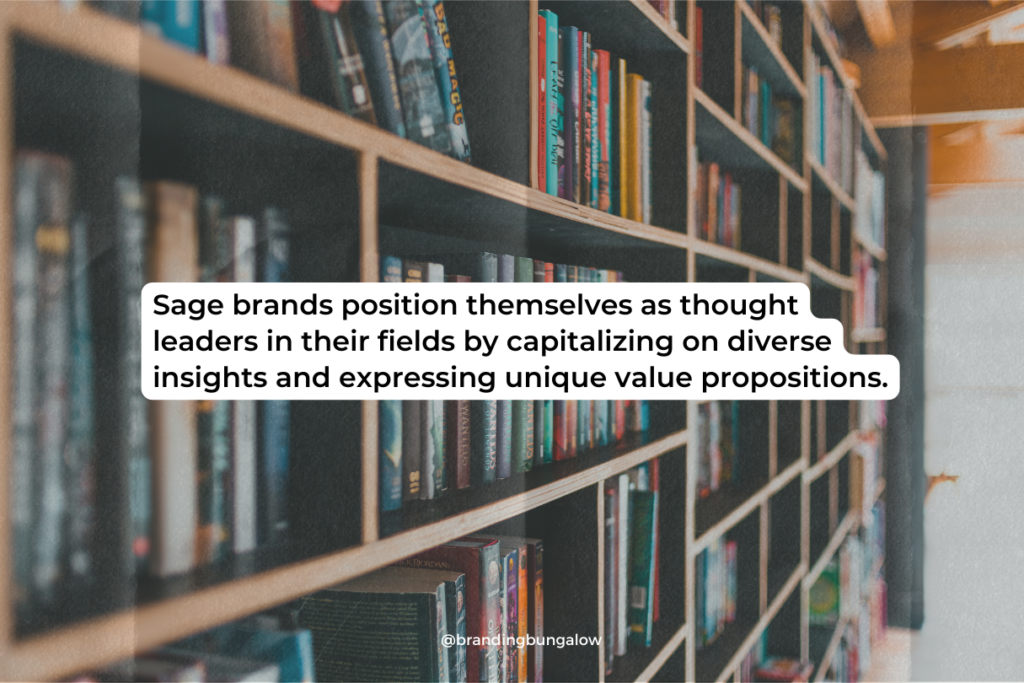
The Sage archetype is the seeker of truth and knowledge, guiding brands like museums and universities in their quest to enlighten and educate. These brands:
- Reject ignorance and misinformation
- Illuminate the world with their wisdom and expertise
- Have transparent messaging
- Provide in-depth content
- Participate in industry events to showcase their commitment to knowledge sharing.
Designing a Sage Brand Strategy
Designing a Sage brand strategy means:
- Positioning the brand as an expert and trusted guide
- Providing consumers with the tools to make informed decisions
- Valuing learning and planning
- Imparting knowledge without condescension
- Ensuring information is accessible and practical.
Sage brands position themselves as thought leaders in their fields by capitalizing on diverse insights and expressing unique value propositions.
The Caregiver Brand: Nurturing and Protective

The Caregiver archetype is the compassionate nurturer, offering empathy and protection, as demonstrated by brands like Pampers and Dove. Within the realms of healthcare, education, and non-profits, Caregiver brands shine, their sincerity and dependability fostering a sense of security and service.
Through supportive activities and service-oriented platforms, these brands connect deeply with their audience, underscoring their commitment to care and protection.
Building a Caregiver Brand Strategy
Building a Caregiver brand strategy involves:
- Creating marketing campaigns that evoke empathy and community
- Establishing strong customer service that personifies understanding
- Using a tone of voice that is warm and welcoming
- Prioritizing customer safety and comfort
- Nurturing a secure bond with the brand
Caregiver brands must also demonstrate authenticity and engage in social responsibility to modernize their image and avoid perceptions of overprotectiveness.
The Magician Brand Archetype: Transformative Experiences
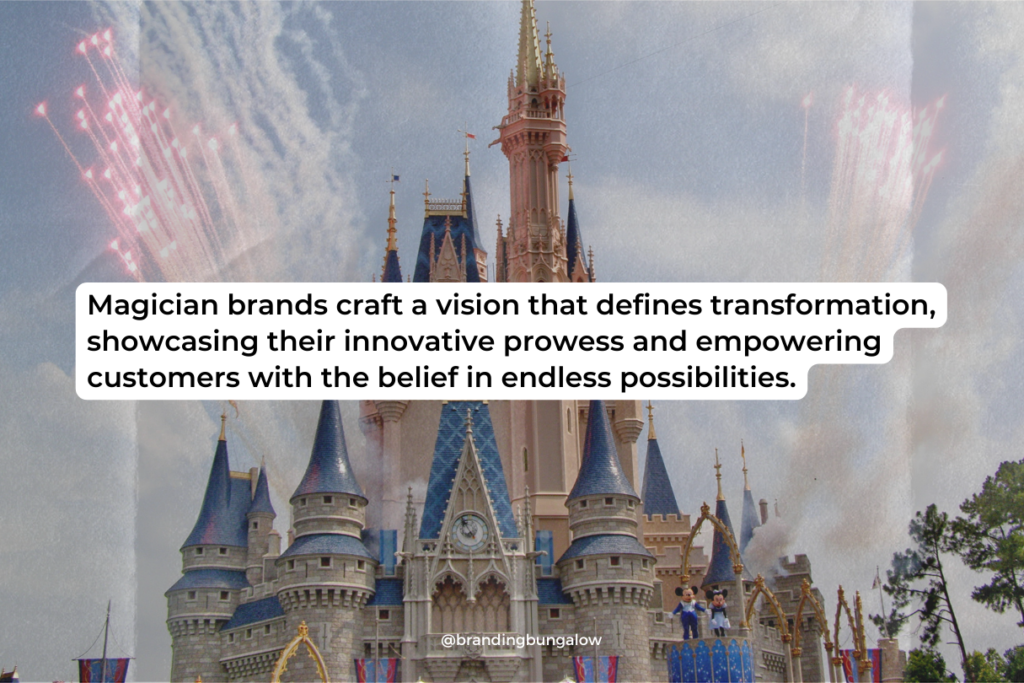
The Magician archetype dazzles with its promise of transformation and innovation, embodied by brands like Disney and Polaroid that deliver experiences beyond the ordinary. These brands craft a vision that defines transformation, showcasing their innovative prowess and empowering customers with the belief in endless possibilities. They are the sorcerers of the market, turning the ordinary into the extraordinary and leading customers into new realms of experience.
Developing a Magician Brand Strategy
Developing a Magician brand strategy involves:
- Curating events and experiences that enchant and surprise
- Leveraging technology to personalize the experience
- Crafting a transformative narrative
- Using testimonials to underscore the enchantment of the brand journey.
Magician brands aim to deliver experiences that are almost spiritual in nature, setting them apart from other archetypes.
The Rebel Brand Archetype: Challenging the Status Quo
The Rebel archetype is the disruptor, forever challenging norms and breaking rules, as seen in brands like Harley-Davidson and Diesel. These brands are the rock stars of the marketing world, their rebellious nature appealing to those who value individuality and freedom.
They are the champions of change, fearlessly taking on ineffective systems and championing the cause of power to the people.
Formulating a Rebel Brand Strategy
Formulating a Rebel brand strategy involves:
- Crafting a brand voice and visuals that are raw, candid, and defy convention
- Showcasing freedom and inspiring audiences to embrace their independence
- Ensuring the brand’s rebellious spirit is communicated without alienating its core market.
It serves as a rallying cry for those who dare to stand out and a guiding light for those with aspirations to challenge the status quo.
The Explorer Brand Archetype: Adventure and Discovery
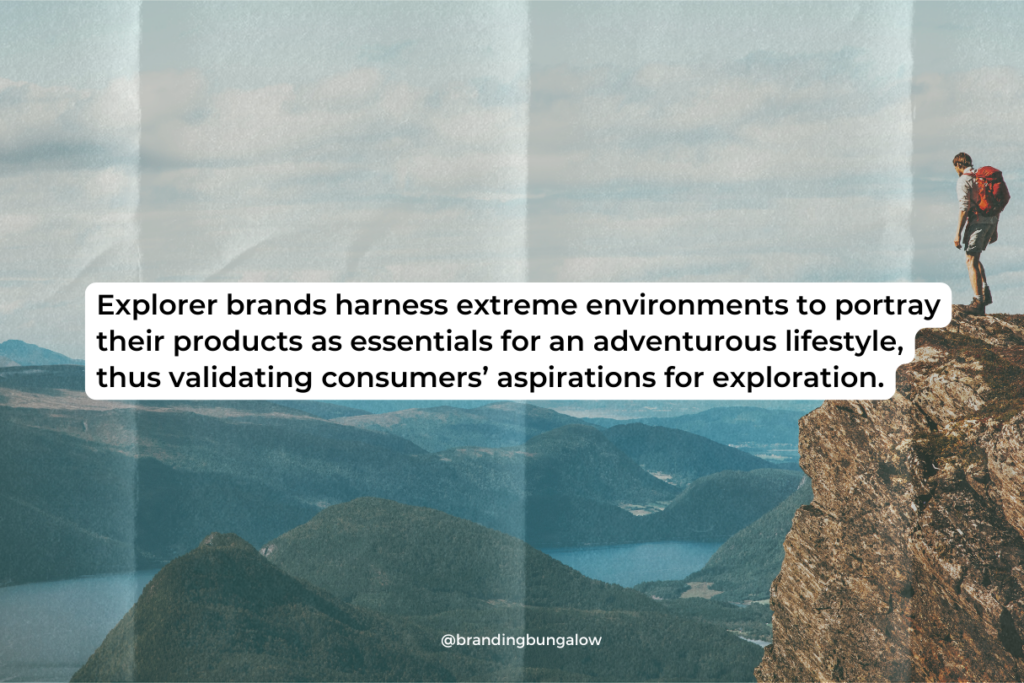
The Explorer archetype is the embodiment of adventure and self-fulfillment, a persona that resonates with brands like Jeep and Red Bull that invite consumers to discover new horizons. These brands are the compasses for those seeking to break free from the mundane and embark on a journey of self-discovery.
They are the guides for the intrepid, encouraging customers to challenge themselves and explore the unknown.
Mapping an Explorer Brand Strategy
Mapping an Explorer brand strategy involves:
- Creating an identity that showcases adventure, curiosity, and resilience
- Ensuring the brand’s mission statement and core values align with themes of discovery and independence
- Harnessing storytelling to evoke exploration, challenge, and transformation
- Inspiring customers to imagine the transformative experiences possible with the products.
Explorer brands like GoPro harness extreme environments to portray their products as essentials for an adventurous lifestyle, thus validating consumers’ aspirations for exploration.
The Ruler Brand Archetype: Authority and Control
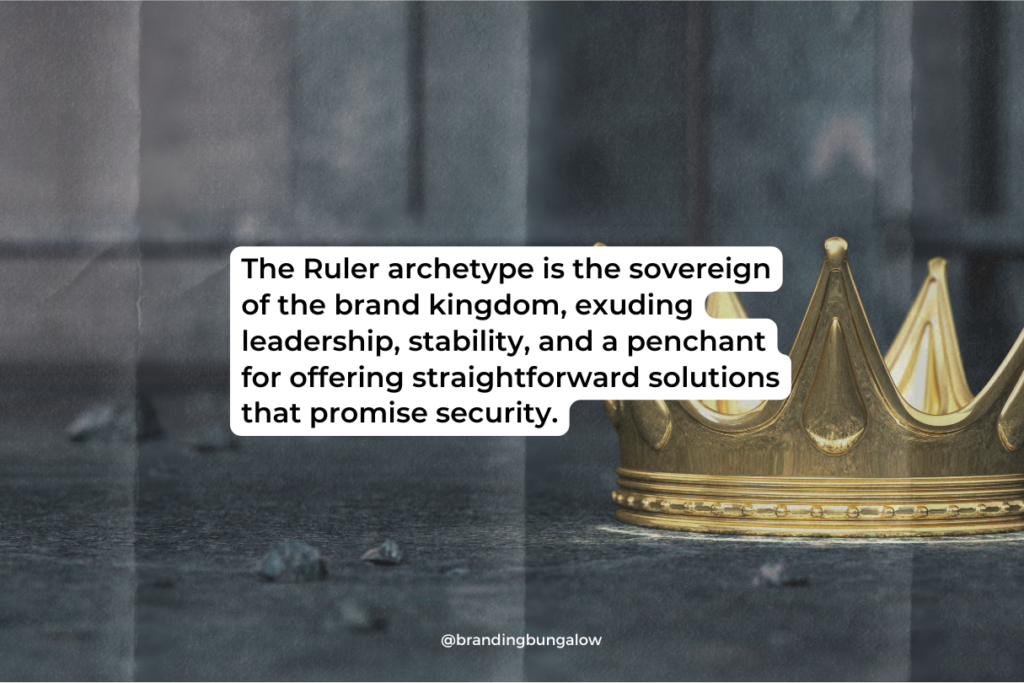
The Ruler archetype is the sovereign of the brand kingdom. They exude leadership, stability, and a penchant for offering straightforward solutions that promise security. Brands that embody this archetype, like Mercedes-Benz and Rolex, convey unmatched excellence and prestige, appealing to consumers who seek control and quality.
Ruler brands must navigate the delicate balance between demonstrating power and maintaining relatability to avoid being perceived as rigid or elitist.
Establishing a Ruler Brand Strategy
To establish a Ruler brand strategy, brands must:
- Exude sophistication and authority
- Communicate a commitment to quality that is unparalleled
- Employ distinctive elements such as proprietary typography and color palettes that reflect their superior status
- Craft marketing narratives that speak of innovation and opulence.
For Ruler brands, crafting a grand narrative that highlights their accomplishments while making consumers feel included in an exclusive, prestigious world is crucial.
The Jester Brand Archetype: Playfulness and Entertainment
The Jester archetype is the life of the party, infusing brand interactions with a playful and entertaining spirit. Brands like Old Spice and Dollar Shave Club are synonymous with the Jester archetype. Their marketing campaigns are filled with wit and humor that engage audiences by bringing joy and light-heartedness to their daily routines.
The Jester brand’s mission should remind us to embrace the fun in life and express ourselves with a spirited laugh.
Infusing a Jester Brand Strategy
Infusing a Jester brand strategy involves:
- Cultivating a joyful company culture
- Ensuring that fun is an integral part of product development and customer service
- Adopting an optimistic and playful brand voice
This strategy resonates with sectors leaning towards entertainment and enjoyment.
From interactive experiences to stand-out packaging, Jester brands leverage bright colors and visuals that evoke movement and fun activities, ensuring their products are designed with humor in mind.
The Everyman Brand Archetype: Belonging and Relatability
The Everyman archetype is the brand next door, embodying values of authenticity, hard work, and inclusivity. Brands that represent the Everyman archetype, such as IKEA and Ford, focus on creating a sense of belonging and acceptance. Their messaging resonates with the desire for community and shared values.
The Everyman archetype’s allure is in its sincerity and relatability, reflecting the diverse backgrounds and experiences of society.
Crafting an Everyman Brand Strategy
Crafting an Everyman brand strategy means:
- Engaging with authenticity
- Highlighting common experiences and values that connect with the everyday person
- Fostering a sense of community and belonging
- Ensuring an inclusive and user-friendly brand experience
- Cultivating an informal, conversational, and empathetic brand voice
These elements are key to creating a successful Everyman brand.
Merging Multiple Archetypes: A Holistic Approach
While each archetype holds its unique power, brands can achieve a more dynamic and relatable personality by merging elements from multiple archetypes. By blending archetypes, like LEGO’s successful combination of the Creator and Explorer, brands can connect with a wider audience and deliver a more nuanced brand message. Maintaining a primary archetype for initial connection is crucial, while employing complementary archetypes can enrich the brand’s persona and mitigate potential weaknesses.
The integration of multiple archetypes should be strategic to avoid muddled messaging and maintain customer trust.
Summary
Throughout this exploration, we’ve traversed the rich landscape of brand archetypes, uncovering the essence of each and how they can be harnessed to craft a brand identity that resonates with the human psyche. From the Hero’s courage to the Sage’s wisdom, each archetype provides a unique lens through which a brand can tell its story and connect with its audience. By understanding and implementing the right archetype strategy, brands can elevate their narrative and create an enduring emotional bond with consumers. Let this be a call to action—a challenge to elevate your brand by embracing the archetypal spirits that have long captivated the human heart and mind.
Frequently Asked Questions
What are the 12 archetypical figures?
The 12 archetypical figures include the Innocent, Everyman, Hero, Outlaw, Explorer, Creator, Ruler, Magician, Lover, Caregiver, Jester, and Sage. Each archetype represents different traits and characteristics.
How do brand archetypes influence consumer behavior?
Brand archetypes influence consumer behavior by creating an emotional connection that aligns with their values and desires, tapping into universal human experiences and emotions.
Can a brand embody more than one archetype?
Yes, a brand can embody multiple archetypes to create a complex and relatable personality. However, it’s crucial to maintain a clear primary archetype for connection.
What is the role of storytelling in archetype-based brand strategies?
Storytelling plays a central role in archetype-based brand strategies. It weaves the brand’s values and personality into a narrative that resonates emotionally with consumers. It helps create a strong and memorable brand identity.
Recent Blog Entries
Discounts to Dubsado CRM, Helcim Payment Processing and...
Brand audits can save your business' sinking marketing ship.
What's happening to Coke and what you can learn from it.
Shop Products
Create a personalize brand board by taking elements from our 3 signature brand board templates.